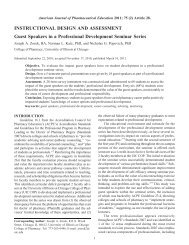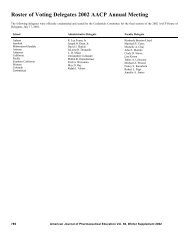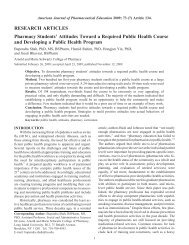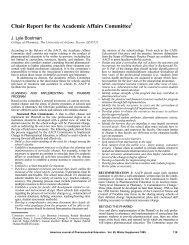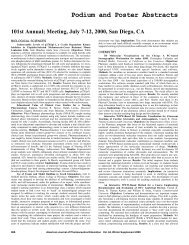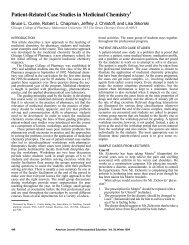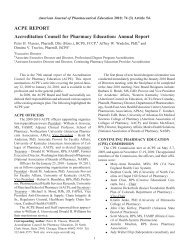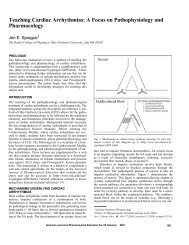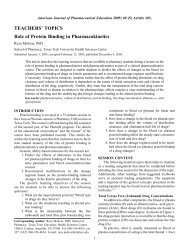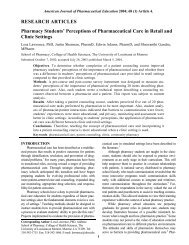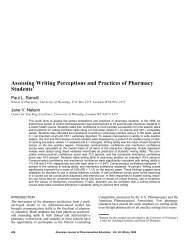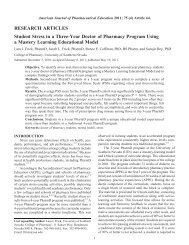View PDF - AJPE
View PDF - AJPE
View PDF - AJPE
Create successful ePaper yourself
Turn your PDF publications into a flip-book with our unique Google optimized e-Paper software.
A Continuous Quality Improvement Model for Developing<br />
Innovative Instructional Strategies 1<br />
JoLaine R. Draugalis and Marion K. Slack<br />
College of Pharmacy The University of Arizona, P.O. Box 210207, Tucson AZ 85721-0207<br />
We used the continuous quality improvement (CQI) process to implement changes in a course in pharmacy<br />
research methods. The goals were to: (i) increase integration between topics within the course and<br />
between it and other courses; (ii) enable students to become self-learners; and (iii) decrease class time<br />
devoted to lecture in anticipation of putting the class notes on the Internet. To increase integration between<br />
courses, the CQI process was applied to homework assignments by identifying the disease states covered<br />
in the pharmacology and medicinal chemistry case discussions. Relevant studies were identified and<br />
used as content for problems. For the research design section, topics were organized within a single conceptual<br />
framework. To enable students to become self-learners in pharmaceutical care practice, strong<br />
skills in reading a research report are needed. We developed a new session at the beginning of the<br />
semester on how to read a research report then provided multiple practice opportunities during classes,<br />
on assignments, and on exams. To decrease lecture time, short, in-class, small group activities were<br />
developed. Evaluation data were primarily student comments and scores on selected exam items. The<br />
CQI process provided an explicit approach to introducing innovative methods into the classroom and<br />
changed our focus from covering material to assuring that students have learned basic skills and concepts.<br />
Our experience indicates that the CQI process should be applicable to a wide range of course<br />
material.<br />
INTRODUCTION<br />
Faculty members in higher education must strive to continually<br />
improve both course content and instructional methods to<br />
enable student learning(1). Specific to pharmaceutical education<br />
is the call that how we teach (and students learn) is as<br />
important as what we teach(2). Therefore there is a need for<br />
pharmacy educators to change from a method based exclusively<br />
on lectures to incorporate student-centered and interactive<br />
methods. The purpose of this article is to describe how a continuous<br />
quality improvement (CQI) framework can be used to<br />
introduce innovative instructional methods in the classroom.<br />
GOALS AND OBJECTIVES<br />
The goal of this innovation was to use the tools of CQI to<br />
address learning issues in a course on pharmacy research methods.<br />
CQI, as we have adapted it, uses insights about student<br />
learning, variation in student performance, and the psychology<br />
of learning to improve the learning process(3). The FOCUS-<br />
PDCA cycle is shown in Figure 1.<br />
The goal of changing the course was to respond to three<br />
objectives:<br />
1. Modify the course content to increase integration and reduce<br />
the amount of material that appears isolated or with little<br />
relationship to other modules in the course and curriculum.<br />
2. Modify the course to enable students to become self-learners.<br />
Continuous learning is a requirement for providing<br />
effective pharmaceutical care. After students leave the<br />
College environment, they will be responsible for their own<br />
learning and one of the primary methods of self-learning is<br />
reading reports of research. Hence, students must be able to<br />
assess the results of research as reported in the literature.<br />
3. Increase class time spent on something other than the transmission<br />
of information in anticipation that class notes will<br />
become available on the Internet so students will not need to<br />
come to class to simply obtain information.<br />
DESCRIPTION OF THE TEACHING INNOVATION<br />
Content. The catalog course description of PhPr 461 -<br />
Methodology in Pharmacy Research. 3 semester credits.<br />
Application of research design, statistical methods, evaluation<br />
techniques, and ethical dimensions to critically evaluate published<br />
literature, research reports, and proposals. The course is<br />
arranged in five parts: (i) introduction; (ii)statistical techniques/data<br />
analysis; (iii) aspects of research design; (iv) fundamentals<br />
of clinical studies; and (v) survey research and epidemiologic<br />
methods. An extensive set of course notes (360 pages) is<br />
disseminated the first day of class. The course purpose is to provide<br />
the student with the skills and principles of clinical research<br />
design and biostatistics needed for evaluation of the medical literature<br />
and assessment of research reports and proposals. The<br />
course has eight objectives. Each instructional topic has specific<br />
learning objectives. The specific course content and mechanics<br />
have been described previously(4,5).<br />
Student Audience/Level of Student. Novice; course has no prerequisites.<br />
Point in the Curriculum Where Used, required course in the<br />
first semester of the second professional year of four-years in an<br />
entry-level PharmD program.<br />
The teaching innovation described is the application of a<br />
CQI process to on-going course evaluation and revisions in PhPr<br />
461. The first learning process that we wanted to improve was<br />
that of integration. For quite some time, we have been integrating<br />
1 Manuscript submitted based on portfolio submited to the 1999 Council of<br />
Faculties Innovations in Teaching competition.<br />
354 American Journal of Pharmaceutical Education Vol. 63, Fall 1999
C - Use data to improve process. Students use homework<br />
assignments to prepare for exams as specific learning objectives<br />
guide the development of both.<br />
A - use of contemporary literature and actual abstracts/articles are<br />
fruitful endeavors - yet improvements are possible.<br />
Understand causes of learning process variation<br />
P - students find it challenging to deal with all the new concepts<br />
presented within the class; students find it difficult to integrate<br />
isolated information presented in the class, given all the<br />
other content-specific information in other courses; students<br />
working alone do not reap as much benefit from the homework<br />
assignments as those students working in study groups.<br />
D - find out what disease states are being covered in<br />
Medicinal Chemistry and Pharmacology and accompanying Case<br />
Discussion via course syllabi and discussion with course coordinators<br />
C - Students appreciate real-world practice examples and<br />
relate to inquiries from practicing pharmacists.<br />
A - Construct assignments to align with other course content<br />
and when possible interject contemporary examples.<br />
Fig. 1. The educational focus - PDCA.<br />
the statistical analysis and study design components. However,<br />
we wanted to increase students' ability to integrate the material<br />
from various units in the class and to increase their ability to integrate<br />
learning from this course with material learned in other<br />
courses. The changes in the course were based on the assumption<br />
that if the instructors can't or don't integrate material in the classroom,<br />
students will be very unlikely to integrate it outside the<br />
classroom.<br />
Process. Using the FOCUS-PDCA approach we will describe<br />
major changes we made in the summer of 1998 and throughout<br />
the fall semester to improve the PhPr 461 experience. The first<br />
example is portrayed in the FOCUS-PDCA framework and others<br />
will follow using a narrative form.<br />
Find process to improve - homework assignments.<br />
Organize team that knows the process - two course instructors<br />
and course teaching assistant (first semester graduate student who<br />
took the course as a Pharm.D. student)<br />
Clarify current knowledge of the learning process<br />
P - Modify approach, content, and construction of homework<br />
assignments.<br />
D - Gather data from 1997 course evaluation form and item<br />
analysis of 1997 homework sets.<br />
Select the learning process improvement<br />
Continually reinforce important concepts in class as well as<br />
on assignments. Content congruence with concurrent coursework<br />
- seek articles and abstracts that match those topics. For example,<br />
Assignments 1, 2, and 5 were directed at GERD, angina, and<br />
asthma that were constructed to match content from other courses.<br />
As well, Assignment 1 was based on one abstract, Assignment<br />
2 on two abstracts, and by the final assignment, students were<br />
required to read an abstract and a complete article in order to<br />
complete the assignment. Encourage formation of study groups<br />
to enhance learning opportunities. Relevance in terms of social<br />
and professional concerns—subscribe to Journal Watch and scan<br />
for useful literature citations/abstracts. Incorporate items based<br />
on topics such as sexually transmitted diseases, consequences of<br />
binge drinking, and safer sex. Use up-to-date applications via<br />
contemporary literature as well as real-world inquiries from practicing<br />
pharmacists. See Appendix A for example homework item<br />
based on a 1996 inquiry from a pharmacist at the Prescott<br />
VAMC.<br />
NARRATIVE EXAMPLES<br />
Three units in the research design section were identified for<br />
major modification: (i) randomization processes, (ii) effects of<br />
subject withdrawals, and (iii) methods of prevention, and compliance.<br />
Previously, each was a stand-alone topic treated in a<br />
single lecture that followed the section of types of research<br />
designs that are taught using the framework of Campbell and<br />
Stanley(6). Salient features of several research designs are presented<br />
with example research reports. Students learn to differentiate<br />
the types of designs and to identify the primary threat to<br />
internal validity associated with each design based on previously<br />
presented threats to internal and external validity. For<br />
example, they learn that an experimental research design is<br />
characterized by use of a random assignment process, and<br />
prospective, parallel comparison groups. The primary threat to<br />
internal validity is experimental mortality (subject withdrawal)<br />
but compliance and randomization are not presented as part of<br />
the cognitive map (a cognitive map is a procedural tool for<br />
guiding analysis) for assessing internal validity. Hence the topics<br />
are isolated from each other and from previous classes on<br />
research design and statistical analysis.<br />
American Journal of Pharmaceutical Education Vol. 63, Fall 1999 355
The strategy we chose for improvement was to extend the<br />
threats of internal validity inherent to the design as identified by<br />
Campbell and Stanley(6) to include threats resulting from the<br />
operational aspects of conducting research as identified by Cook<br />
and Campbell(7). An introductory section was developed to<br />
define the two types of threats to internal validity and to review<br />
the research designs and the associated threats listed by Campbell<br />
and Stanley.<br />
The approach is used again in the following semester when<br />
students are given example research reports to assess in the Drug<br />
Information course. Students have three 75-minute class sessions<br />
in which they analyze research reports. The initial analysis is the<br />
same analysis that was used with example articles in the Methods<br />
course. However, as we analyze the articles, we expand the discussion<br />
to include operational threats to internal validity. Students<br />
are provided with a chart (see Appendix B) to guide their analysis.<br />
The second learning process that we wanted to improve was<br />
students' self-learning ability. Our understanding of the selflearning<br />
process of practitioners indicates that practitioners must<br />
be able to read and assess reports of research to continue to learn<br />
after leaving the classroom. This is especially crucial in light of<br />
the pharmaceutical care practice philosophy. To enable students<br />
to be change agents and implement innovative practices, they<br />
need to be able to use the literature. One only needs to consider<br />
the APhA practice principles of data collection, information evaluation,<br />
formulating a plan, implementing the plan, and monitoring<br />
and modifying the plan/assuring positive outcomes, to see<br />
this obvious connection(8).<br />
We decided that one strategy for increasing self-learning<br />
abilities was to enable students to read research reports at the<br />
beginning of the class then provide them with practice throughout<br />
the Methods course through a variety of means that is reinforced<br />
the following semester in the Drug Information course.<br />
The change also was to respond to observations during an<br />
in-class exercise. Students were asked to read a table of results<br />
from a report and respond to questions about the p-values presented.<br />
Listening in on the students' discussions revealed that students<br />
did not know how to read a table. They did not recognize<br />
that the table was structured to provide information on the independent<br />
and dependent variables.<br />
In addition, the modification responds to a realization that<br />
self-learning is facilitated if students have mastered basic skills.<br />
Self-learning from research reports will be greatly hindered if students<br />
have not learned to identify the independent and dependent<br />
variables in a study. Observations over several years have convinced<br />
us that this is a difficult skill to learn despite its basic<br />
nature and despite the fact that it was being addressed frequently<br />
throughout the course. Differentiating between types of variables<br />
is based on concept learning and concepts are learned with<br />
repeated practice with examples(9). Therefore, a unit on reading<br />
a research report was developed and put into the second class session<br />
so that students could begin practice with these concepts<br />
early.<br />
The basic skill of reading a research report requires that students<br />
be able to identify the components of the report (i.e.,<br />
abstract, introduction, methods, results, discussion, and conclusions)<br />
and that they understand the logic behind the information<br />
presented. Therefore a unit was developed to teach students the<br />
components of a research report and how to follow the logic of a<br />
report. Students begin by identifying the section of a report in<br />
which excerpts from a research report appear. Then they are provided<br />
with a cognitive map (skeleton) of a research report and we<br />
work through an example report in class.<br />
The independent and dependent variables are identified and<br />
tracked through the report. Students are shown how to identify<br />
the variables in the purpose statement, how the independent variable<br />
(treatment) and the dependent variable are described in the<br />
methods section, and how the measures on the dependent variable<br />
are reported according to level of treatment in the results section.<br />
Specifically, we look at tables and discuss how they are set<br />
up to show both the independent and dependent variables and the<br />
results of statistical testing. Students are sometimes amazed that<br />
each section of the report is related!<br />
Skills related to reading and interpreting a research report<br />
are reinforced throughout the semester in class materials, assignments,<br />
and on examinations. For example, items related to reading<br />
tables appear on two exams. At the end of the research design<br />
section we again review the logical process for evaluating statistical<br />
conclusion validity, internal validity, and external validity.<br />
Development of in-class activities was the strategy chosen to<br />
make class time more than an opportunity to transmit information.<br />
The purpose of the course is for students to learn the basic<br />
concepts of statistics and research design so that they can understand<br />
and evaluate research literature. Again, concepts are learned<br />
through examples and application(9). Therefore, the most effective<br />
instructional strategy will provide students with an opportunity<br />
to differentiate examples and apply concepts. In-class activities<br />
provide that opportunity.<br />
Short in-class activities have been developed for the first two<br />
classes and for several of the research design classes. The first<br />
class provides information on the scientific method, the role of<br />
statistics, and inference of cause and effect. The first in-class<br />
activity asks students to "write an example hypothesis and identify<br />
the independent and dependent variables." Students are<br />
allowed 5 to 10 minutes for the task and then it is discussed in<br />
class. Example hypotheses with their independent and dependent<br />
variables are written on the board and questions answered.<br />
The in-class activity during the second class is designed to<br />
help students learn to identify the sections of a research report.<br />
Statements from a report are excerpted and students are asked to<br />
identify the section of the research report where the statement<br />
would be located. After students complete the activity, their<br />
responses are discussed as a class.<br />
In-class activities in the research design section include a<br />
fill-in the blank vocabulary review and study questions for quasiexperimental<br />
designs. Two activities are provided for the unit on<br />
randomization. During most in-class activities students are<br />
encouraged to work in pairs or small groups of three or four and<br />
discuss the activity. At the end of the task, a raised hand is used<br />
to bring the group together again to discuss responses on the<br />
questions.<br />
In-class activities provide numerous teachable moments.<br />
For example, in the exercise asking students to state a hypothesis<br />
with its independent and dependent variable, one group of students<br />
hypothesized that tight shoes cause pain. Their independent<br />
variable was shoe fit (good versus tight) which led to a discussion<br />
of how the investigator would operationalize the concept of "tight<br />
shoes." One suggestion was to provide subjects with shoes two<br />
sizes too small.<br />
EVIDENCE OF STUDENTLEARNING<br />
We assess application and other higher levels of learning by constructing<br />
items using examples that require students to apply concept<br />
skills rather than simply recognize or recall information.<br />
Additional specifics such as reliability assessment and item<br />
analysis techniques are provided in previous articles(4,5).<br />
Students appreciate the homework assignments, both<br />
356 American Journal of Pharmaceutical Education Vol. 63, Fall 1999
ecause they constitute 25 percent of the course grade and<br />
because they are useful study guides for examinations. We<br />
encourage students to indicate why some choices are wrong -<br />
which can be quite illuminating for instructors and students alike.<br />
The in-class exercises provide some of the most useful and<br />
current information on learning. Particularly informative are<br />
small group or pair discussions of how to do an exercise or the<br />
meaning of the question. For instance, while students were completing<br />
a sorting task, two students were having a discussion on<br />
whether a research report was written in present or past tense. The<br />
instructor can intervene and clarify the issue with the individual<br />
students then discuss the topic again with the entire class.<br />
Both instructors are frequently approached by third and<br />
fourth year students to discuss using cognitive maps and skills<br />
developed in the course when the students need to evaluate literature<br />
reports in other courses and on their clerkship rotations. In<br />
our curriculum students are required to carry out an investigative<br />
senior project. Application of concepts and skills acquired in the<br />
PhPr 461 course is evidenced in students' proposals, conduct of<br />
study, and final presentations. We believe the CQI-generated<br />
innovative strategies will engender even increased application<br />
and use of course skills and materials.<br />
EVALUATIVE DATA<br />
Two previous papers provide evidence of peer-review of previous<br />
course planning: delivery(4), and revisions(5). One of the methods<br />
we use to evaluate the course is to have a discussion in class<br />
about specific sections of the course. Students are asked for comments<br />
and are also asked specific questions. After adding the inclass<br />
exercises this past year, students were asked about that<br />
aspect of the course. In general, the students seemed to like the<br />
exercises and several students were vocal about preferring inclass<br />
exercises to lectures.<br />
At the conclusion of the fall 1998 semester, students consistently<br />
rated both instructors as being highly effective and both are<br />
thought to clearly communicate and explain concepts and ideas<br />
by providing examples and relevant applications as rated by students<br />
on instructor evaluation forms. At the end of the semester<br />
students were positive in the evaluation of handouts/supplementary<br />
course materials, the utility of assignments, and course organization<br />
(all items averaged 4.3 or higher on a five-point scale).<br />
The more telling story comes from students after completing<br />
the course - both in their remaining time in the school as well as<br />
from alumni. Some examples were provided in the previous section<br />
about how evidence of student learning is manifested later in<br />
the curriculum. The more senior students have been heard telling<br />
their more junior colleagues, to make sure and save the "461<br />
Book" as they will be sure to use it. Numerous alumni have told<br />
us that they frequently consult the course notes as they evaluate<br />
proposals and the professional literature - and many are surprised<br />
that these course materials are the ones they have used the most<br />
post-graduation!<br />
PERSONAL REFLECTIONS - LESSONS LEARNED<br />
The CQI approach represents an explicit approach to improving<br />
the quality of teaching and subsequent learning as well as an ongoing<br />
and incremental approach to innovation. Using this method<br />
over a period of years can have a substantial cumulative effect.<br />
The traditional method of altering courses is primarily reactive.<br />
Problems are brought to the attention of the instructor or the college<br />
administration and the instructor responds by changing lectures.<br />
The CQI process is a proactive approach; that is, student<br />
outcomes are evaluated, issues identified, the learning process is<br />
examined, and based on the type of learning required, changes are<br />
made. It is a change in focus from that of covering material to<br />
assuring that students have learned basic concepts and skills. The<br />
goal is for students to be able to perform basic cognitive skills<br />
rather than to recall a large quantity of information for an exam.<br />
Frustration with process and some outcomes led us to try<br />
new approaches. In the past, we have tried having the students<br />
divide into small groups to respond to questions then the instructor<br />
led a discussion of responses to the questions as a class. The<br />
classrooms are not designed in a way that is conducive to group<br />
discussions and it seems to create a lot of chaos trying to divide<br />
students into specific groups. Therefore, when we wanted to add<br />
in-class exercises, we used pairs or small groups (up to four students)<br />
without having to physically move around the room. It<br />
seems to create less chaos while allowing students to discuss the<br />
items in the activity.<br />
Another lesson learned is related to the selection of articles<br />
for examples in class and for assignment purposes. The articles<br />
need to be well written as the students are novices and it is difficult<br />
for them to identify clear examples - to sort through a poorly<br />
written article is beyond their level of skill as well as extremely<br />
time consuming. It is difficult to put oneself in the students'<br />
position and recognize what tyros they really are. The articles<br />
need to be short and sometimes abstracts will suffice. Again students<br />
are beginners and it usually takes them a considerable<br />
amount of time to read even a short report. The study also needs<br />
to be relatively simple, preferably with one independent variable<br />
and not more than two or three dependent variables with simple<br />
statistics - many times a tall order. The topic also needs to be relevant<br />
to pharmaceutical care. Given such strict criteria, appropriate<br />
articles are not easy to locate. Given the attitude of most students<br />
toward statistics and research design, the introductory<br />
example article concerned with the treatment of anal fissures<br />
offers an opportunity for a little levity.<br />
CONCLUSIONS<br />
Eventually we hope to hang all materials on the college web<br />
page, so it will be even more unnecessary to come to class for<br />
only information dissemination, rather we'll be doing even<br />
more in-class exercises and discussion and application of principles<br />
and concepts. We plan to incorporate some of the homework<br />
assignment activities as in-class activities so more interaction<br />
and discussion are stimulated. A recent modification of<br />
our main lecture hall including an ergonomic-designed podium;<br />
digital switching system (among PC, Elmo digital presenter;<br />
and VCR) three external sources; and wireless keyboard<br />
will also provide us with additional opportunities. We plan to<br />
return to a competency-based final exam where previously we<br />
had an open-book final and the students answered inquiries<br />
about two articles and/or abstracts they were given.<br />
We recognize and agree with Susan Johnston's (10) seven<br />
deadly assumptions:<br />
• Students will apply the content on their own after class.<br />
• Students don't need instruction or tasks to be structured.<br />
• Students learn best by hearing the expert version first.<br />
• Students can integrate new information by just listening<br />
well.<br />
• Students should do their own work during class time.<br />
• Students don't need much guidance from the instructor.<br />
• Students overcome complexity gaps between class work<br />
and tests.<br />
We will keep these assumptions in mind as we continually<br />
strive to improve the PhPr 461 learning experience. Faculty<br />
members of all academic disciplines could apply the CQI<br />
American Journal of Pharmaceutical Education Vol. 63, Fall 1999 357
Model to any learning process in an effort to develop innovative<br />
instructional strategies.<br />
Am. J. Pharm. Educ., 63, 354-358(1999); received 7/14/99.<br />
References<br />
(1) Boyer, E.L., College - The Undergraduate Experience in America. Harper<br />
and Row Publishers, New York NY (1987) p. 159.<br />
(2) Commission to Implement Change in Pharmaceutical Education,<br />
"Background Paper II: Entry-level curricular outcomes, curricular content<br />
and educational process," Am. J. Pharm. Educ., 57, 377-385(1993).<br />
(3) McLaughlin, C.P. and Kaluzny, A.D., Continuous Quality Improvement in<br />
HealthCare: Theory, Implementation, and Applications. Aspen Publishers,<br />
Inc., Gaithersburg MD (1994).<br />
(4) Draugalis, J.R. and Slack, M.K., "A course model for teaching research<br />
evaluation in colleges of pharmacy," Am. J. Pharm. Educ., 56, 48-52(1992).<br />
(5) Draugalis, J.R., Carter, J.T. and Slack, M.K., "Survey course on research<br />
methods: Integrating statistical analysis and study design," ibid. 62, 17-<br />
23(1998).<br />
(6) Campbell, D.T. and Stanley, J.C., Experimental and Quasi-Experimental<br />
Designs for Research. Houghton Mifflin Company, Boston MA (1963).<br />
(7) Cook, T.D. and Campbell, D.T., Quasi-Experimentation-Design & Analysis<br />
Issues for Field Settings. Houghton Mifflin Company, Boston MA (1979).<br />
(8) Rovers, J.R, Currie, J.D., Hagel, H.P., McDonough, R.P. and Sobotka, J.L,<br />
A Practical Guide to Pharmaceutical Care. American Pharmaceutical<br />
Association, Washington DC. (1998) pp. 222-224.<br />
(9) Merrill, M.D. and Tennyson, R.D., Teaching Concepts: An Instructional<br />
Design Guide. Educational Technology Publications, Englewood Cliffs<br />
NJ (1977).<br />
(10) Johnston, S., "Supporting student success in the classroom," Cooperative<br />
Learning and College Teaching,. 8(3), 11-14(1998).<br />
APPENDIX A. HOMEWORK ITEM BASED ON<br />
PRACTITIONER INQUIRY<br />
Accepted medical therapy of benign prostatic hypertrophy (BPH) includes<br />
alpha blocking drugs and finasteride. Although these therapies have modest<br />
efficacy in treating this condition, they also have certain disadvantages.<br />
Finasteride is considered safe, but takes months of therapy before efficacy<br />
can be assessed and is costly. Unlike finasteride, alpha blocking drugs are<br />
relatively inexpensive and work quickly, but can cause hypotension and<br />
other effects which may lead to discontinuation of the drug. Saw palmetto<br />
may offer an alternative to both finasteride and alpha blockers. Saw palmetto<br />
extract is available in health food stores and in pharmacies specifically<br />
for treatment of BPH and is inexpensive. Although there is one large<br />
open label study which suggests efficacy and safety of saw palmetto in<br />
BPH, there are few controlled studies examining its use in this disease.<br />
Therefore, a controlled trial at the Prescott VAMC would offer additional<br />
data on the usefulness of saw palmetto extract in patients with BPH.<br />
Approximately fifly men would be available to participate in this study.<br />
The pharmacist at the VAMC has called you asking for advice on<br />
how many subjects would be required to complete this study. Data<br />
will be analyzed by comparing maximal urinary flow rate between the<br />
placebo and saw palmetto treatment groups. The researchers are looking<br />
for a 1.7 ml/sec difference in maximal urinary flow rate and the<br />
literature suggests a standard deviation of 3.5 ml/sec. Using an alpha<br />
level of 0.05, a nondirectional alternative hypothesis, and a desired<br />
power of 0.90; how many men should be enrolled in the study?<br />
On the basis of suggested sample size, would you recommend that the<br />
pharmacist pursue this inquiry at the Prescott VAMC? Why or why not?<br />
APPENDIX B. PROBLEMS WITH INTERNAL VALIDITY ASSOCIATED WITH EXPERIMENTAL STUDY DESIGNS<br />
Description of Problem and Effect on Study Results<br />
Problem Difference is Statistically Significant Difference is Not Statistically Significant<br />
Problems inherent to the design:<br />
1. Experimental mortality 1a. Differential drop out (e.g., only<br />
participants who would get well<br />
anyway are left in treatment group)<br />
1b. Subjects are dropped from statistical<br />
analysis in a manner that favors the<br />
treatment.<br />
Operational Problems: (problems resulting from how the study is implemented)<br />
2. Randomization process 2a. Unequal groups result from chance<br />
inherent to randomization process.<br />
2b. Bias in execution assigns participants<br />
who will get well anyway to<br />
the treatment group.<br />
3. Reactivity secondary to failed<br />
blinding or knowledge of<br />
assignment<br />
3a. Demoralization of control group.<br />
3b. Biased evaluation so that treatment<br />
group is evaluated as better<br />
4. Placebo has therapeutic<br />
The placebo is actually harmful to<br />
properties (if applicable)<br />
participants so that treatment appears better<br />
5. Adherence to protocol 5a. Protocol is violated in some way<br />
that gives treatment group the<br />
advantage. (Particularly problem<br />
atic if the study is unblinded or<br />
there was a breakdown in the<br />
randomization process.)<br />
5b. Treatment group is nonadherent but<br />
responds anyway<br />
Problems related to scientific misconduct:<br />
6. Scientific misconduct 6a. Data are manufactured or altered<br />
to favor the treatment<br />
6b. Data contrary to the hypothesis<br />
are dropped intentionally from<br />
the statistical analysis.<br />
la. Differential drop out, e.g.,<br />
slightly ill drop out of treatment<br />
group and the severely ill out<br />
of placebo group so no difference<br />
is found,<br />
1b. Excessive drop out reduces power of<br />
study<br />
2a. Unequal groups result from chance<br />
inherent to randomization process.<br />
2b. Differential assignment to groups<br />
especially if treatment is seen as<br />
much more desirable than the<br />
alternative.<br />
3a. Biased evaluation of control group; if<br />
placebo, possibly a John Henry effect,<br />
3b. Contamination of the control group.<br />
Placebo is actually therapeutic so that<br />
no treatment effect is evident.<br />
Placebo is actually therapeutic so that no<br />
treatment effect is evident.<br />
5a. An inadequate dose of the<br />
therapeutic agent is used so effects<br />
are small,<br />
5b. Poor adherence by participants<br />
in the treatment group so<br />
effect is reduced.<br />
5c. Diagnostic or other errors<br />
committed during admission to study<br />
so that participants do not respond to treatment.<br />
Data are sabotaged by someone<br />
working on the study.<br />
358 American Journal of Pharmaceutical Education Vol. 63, Fall 1999



